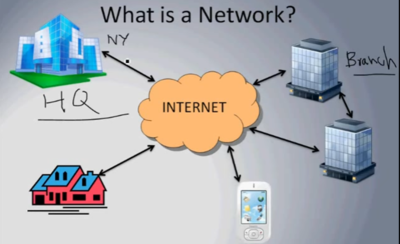Difference between revisions of "Network"
(A network is a collection of computers, servers, mainframes, network devices, peripherals, or other devices connected to one another to allow the sharing of data.) |
m (The LinkTitles extension automatically added links to existing pages (https://github.com/bovender/LinkTitles).) |
||
| Line 1: | Line 1: | ||
| − | A network is a collection of computers, servers, mainframes, network devices, peripherals, or other devices connected to one another to allow the sharing of data. A excellent example of a network is the Internet, which connects millions of people all over the world. Below is an example image of a home network with multiple computers and other network devices all connected to each other and the Internet.<ref>What is a Network? [http://www.computerhope.com/jargon/n/network.htm computerhope]</ref> | + | A network is a collection of computers, servers, mainframes, network devices, peripherals, or other devices connected to one another to allow the sharing of [[data]]. A excellent example of a network is the [[Internet]], which connects millions of people all over the world. Below is an example image of a home network with multiple computers and other network devices all connected to each other and the Internet.<ref>What is a Network? [http://www.computerhope.com/jargon/n/network.htm computerhope]</ref> |
| Line 16: | Line 16: | ||
'''Network Characteristics'''<ref>Network Characteristics [http://www.webopedia.com/TERM/N/network.html Webopedia]</ref><br /> | '''Network Characteristics'''<ref>Network Characteristics [http://www.webopedia.com/TERM/N/network.html Webopedia]</ref><br /> | ||
In addition to these types, the following characteristics are also used to categorize different types of networks: | In addition to these types, the following characteristics are also used to categorize different types of networks: | ||
| − | *[[Network_Topology|Topology]]: The geometric arrangement of a computer system. Common topologies include a bus, star, and ring. See the Network topology diagrams in the Quick Reference section of Webopedia. | + | *[[Network_Topology|Topology]]: The geometric arrangement of a [[computer]] [[system]]. Common topologies include a bus, star, and ring. See the Network topology diagrams in the Quick Reference section of Webopedia. |
| − | *[[Network_Protocol|Protocol]]: The protocol defines a common set of rules and signals that computers on the network use to communicate. One of the most popular protocols for LANs is called Ethernet. Another popular LAN protocol for PCs is the IBM token-ring network . | + | *[[Network_Protocol|Protocol]]: The protocol defines a common set of rules and signals that computers on the network use to communicate. One of the most popular protocols for LANs is called [[Ethernet]]. Another popular LAN protocol for PCs is the IBM token-ring network . |
| − | *[[Network_Architecture|Architecture]]: Networks can be broadly classified as using either a peer-to-peer or client/server architecture. | + | *[[Network_Architecture|Architecture]]: Networks can be broadly classified as using either a peer-to-peer or client/server [[architecture]]. |
Computers on a network are sometimes called nodes. Computers and devices that allocate resources for a network are called servers. | Computers on a network are sometimes called nodes. Computers and devices that allocate resources for a network are called servers. | ||
Revision as of 17:14, 6 February 2021
A network is a collection of computers, servers, mainframes, network devices, peripherals, or other devices connected to one another to allow the sharing of data. A excellent example of a network is the Internet, which connects millions of people all over the world. Below is an example image of a home network with multiple computers and other network devices all connected to each other and the Internet.[1]

source: Computerseekho
Types of Network[2]
Two very common types of networks include:
You may also see references to a Metropolitan Area Network (MAN), a Wireless LAN (WLAN), or a Wireless WAN (WWAN).
Network Characteristics[3]
In addition to these types, the following characteristics are also used to categorize different types of networks:
- Topology: The geometric arrangement of a computer system. Common topologies include a bus, star, and ring. See the Network topology diagrams in the Quick Reference section of Webopedia.
- Protocol: The protocol defines a common set of rules and signals that computers on the network use to communicate. One of the most popular protocols for LANs is called Ethernet. Another popular LAN protocol for PCs is the IBM token-ring network .
- Architecture: Networks can be broadly classified as using either a peer-to-peer or client/server architecture.
Computers on a network are sometimes called nodes. Computers and devices that allocate resources for a network are called servers.
References
Further Reading
- Computer Network Definition Wikipedia
- What is Computer Network Techtarget
- What is a Network - Definition and Meaning Business Dictionary
